
|
Odd Man Out (1947, UK)
In producer/director Carol Reed's searing, taut and
suspenseful crime-chase (melo)-drama and noirish British post-war
thriller (adapted from F.L. Green's 1945 novel) with gritty black
and white cinematography - a rich character study about a rebel leader
- a doomed man-on-the-run:
- an opening crawl was superimposed
over an aerial view of Belfast: "This story is told against
a background of political unrest in a city of Northern Ireland.
It is not concerned with the struggle between the law and an illegal
organisation, but only with the conflict in the hearts of the people
when they become unexpectedly involved"
- an early scene in a cramped
row-house introduced rebellious Irish underground leader and IRA-like
nationalist gunman Johnny McQueen (James Mason in one of his best
performances), six months after escaping from prison; he was hiding
out in the house of his loving girlfriend Kathleen Sullivan (Kathleen
Ryan in her debut film) and her Grannie (Kitty Kirwan)
- with his compatriots, he was planning a daring payroll robbery-holdup (presumably
in Belfast in N. Ireland) of a factory mill, to fund the underground
IRA operations of "The Organization"
|
Johnny Suffering From Vertigo Before and During
Holdup
|

|

|
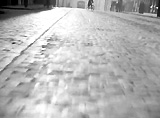
|

Dizzyness
|
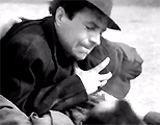
Shot in Shoulder
|
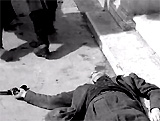
Murder of Armed Cashier
|
- McQueen's vertigo was represented
on the way to the robbery and during the ill-advised, unsuccessful
robbery-holdup attempt - the buildings and other passing objects
were at sharp angles, his vision blurred, and he appeared delirious;
after the heist, McQueen stumbled on the front steps as he approached
the get-away car parked outside, driven by hothead Pat (Cyril Cusack),
and as he fought off an armed cashier at the mill, he was lethally-wounded
in the left shoulder before killing the man; and then as the getaway
car sped away, he was unable to fully get into the vehicle from
the running board - he fell onto the street and had to be left
behind
- for the remainder of the film, Johnny lost control
of his destiny (and free will) as he desperately struggled to avoid
capture, and stumbled through the streets of Belfast (disguised)
while trying to hide; when not able to make it back to Kathleen's
house, Johnny sought shelter in the city's ghettos, air-raid shelter,
deserted buildings, pubs, and back alleys (and even in a junkyard
bathtub on the edge of town); he also continued to experience hallucinations,
irrationality and mental torment
- as the British dragnet around him closed in tighter,
for eight tense hours in a series of expressionistic chase sequences,
the increasingly-delirious Johnny was pursued in a manhunt by the
police and others - all with their own motives
of either helping him, dismissing him out of fear, or exploiting
him by turning him in to the authorities to claim the £50,000
reward; they included Johnny's girlfriend Kathleen, his IRA buddy-partners
Dennis (Robert Beatty), Pat and Nolan (Dan O'Herlihy) who wanted
to rescue him (Pat and Nolan were gunned down after informed upon),
informer Theresa O'Brien (Maureen Delaney), law-enforcing police
Inspector (Denis O'Dea), hansom cab-driver "Gin" Jimmy
(Joseph Tomelty), bird-dealer and poor street con-man/hustler Shell
(F. J. McCormick), forgiving Catholic priest and Johnny's childhood
teacher Father Tom (W. G. Fay), bar proprietor Fencie (William
Hartnell), crazed, bedeviled, and drunken and eccentric homosexual
painter Lukey (Robert Newton)
|
Various Characters Circling Around Johnny
|

Inspector with Informant Theresa O'Brien
|

Hansom Cab-Driver "Gin" Jimmy
|

Bird-Dealer and Poor Street Hustler Shell
|

Catholic Priest Father Tom
|

Bar Proprietor Fencie
|

Crazed, Drunken and Eccentric Homosexual Painter
Lukey
|
- Johnny additionally imagined faces from conversations
of people who he had recently been confronted by, in the bubbles
of his spilled beer on the counter in Mr. Fencie's bar, and later
in Lukey's studio lined with paintings, Johnny experienced a delirious
vision of the paintings flying off the wall

|
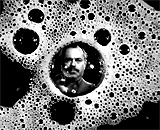
|

Flying Paintings
|
|
Faces in Beer Bubbles
|
- in the film's visual religious symbolism of crucifixion,
McQueen became a Christ-like figure as a condemned man slowly approaching
death - when brought to Lukey's building, McQueen was compelled
to pose for the painter for endless hours as a model for a series
of Christ paintings; the artist was obsessed with painting the
eyes of the dying man as he noted: ("there's something to
be said about him before he dies...I understand what I see in him....It's
the truth about us all....He's doomed"); he discussed his
obsession with failed ex-medical intern student Tober (Elwyn Brook-Jones),
Shell's house-mate, who was attempting to treat the seriously-wounded
Johnny
- with a low-angled view of
Johnny with a sling on his arm, he delivered a crazed hallucinatory
recitation of the Bible (I Corinthians 13) from words he learned
from Father Tom as a child: ("I remember.
When I was a child, I spoke as a child, I thought as a child, I understood
as a child. But when I became a man, I put away childish things.
Though I speak with the tongues of men and of angels and have not
charity, I am become a sounding brass or a tinkling cymbal. Though
I have the gift of prophecy and understand all mysteries and all
knowledge and though I have all faiths so that I could remove mountains
and have not charity, I am nothing"); Lukey reacted:
"He's mad, he's out of his mind"
- in the powerful and violent finale in a very snowy
Belfast, girlfriend Kathleen finally met up with Johnny; he thought
she was another dreamy vision - he asked: "Is it really you?...If
you are real, stretch out your hand to mine"; she rushed into
his arms and embraced him; he then asked: "What d'you want with
me? Go back to life and peace" - she assured him: "I'll
stay with you, my love"; he told her: "Hold up your head.
Don't cry"
- at the sound of a foghorn of a ship announcing its
imminent departure at the waterfront, she told him that she had arranged
for their escape: "That's our chance. Will you take it with
me?"; he asked: "Is it far?" and she promised: "Keep holding
my hand" - she slowly assisted him to the dock as the police manhunt closed in
on them - and their ship was leaving without them in the distance; when he tired and
fell back against an iron gate (with arms extended in a crucifix
pose), he wondered: "Kathleen, where are you?" - and she responded:
"It's all right, Johnny. I'm here";
again, he asked: "Is it far?" - she told him: "It's
a long way Johnny, but I'm coming with you - we're going away together"
- Kathleen had protectively decided to transcendentally
and romantically sacrifice herself with Johnny rather than let him
endure capture and execution; she
reached into her pocket, pulled out a gun seen in closeup, and fired
two shots as the police approached closer; it was ambiguous whether she
fired at the police to force them to retaliate, or killed Johnny to
prevent him from being captured by the police; they were both left dead
by police in a barrage of return gunfire (off-screen), and expired in
each other's arms on the snow-covered ground; the Inspector was informed: "There's
their gun, sir" - he inspected the gun: "Two
shots fired," and was told in the film's final line of dialogue: "Yes
sir, that's when we had to fire back"
- the sound of the foghorn (with the departing ship) ended the film
as witnesses Father Tom and Shell walked away from the tragic scene

Crucifix Pose Against Iron Gate
|

"I'm
coming with you"
|

"We're
going away together"
|

Kathleen's Two Shots
|

Bodies in Snow
|

("Two shots fired") - "Yes
sir, that's when we had to fire back"
|
|

Johnny McQueen (James Mason)

Johnny's Planned Robbery Compatriots, Including Kathleen
(in back)

Kathleen (Kathleen Ryan)

Johnny Left Behind After Robbery - Stranded in Streets of
Belfast

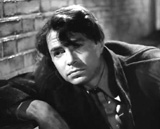
On the Run - As a Delirious Fugitive

Johnny Reclining in Washtub

Wandering in Snow

Lukey: "There's something to be said about him
before he dies..."

Johnny Posing As Model for Lukey, As Tober Operated


Johnny's Recitation of I Corinthians 13

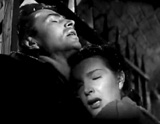

Last Moments Together
|
















